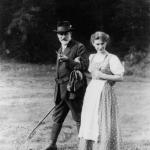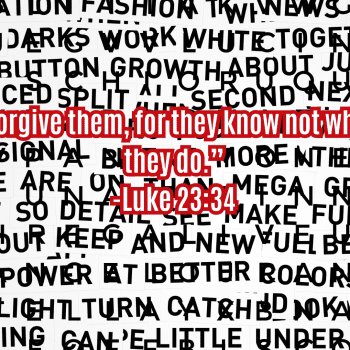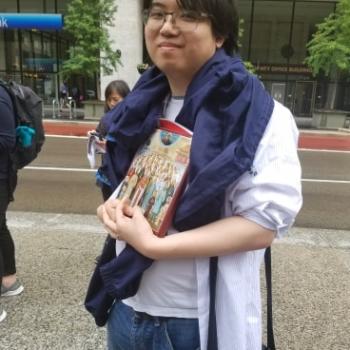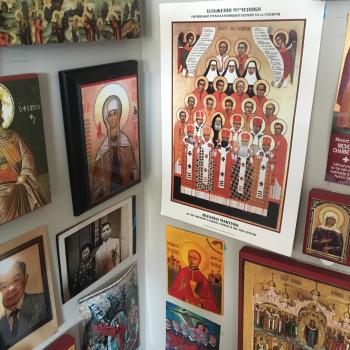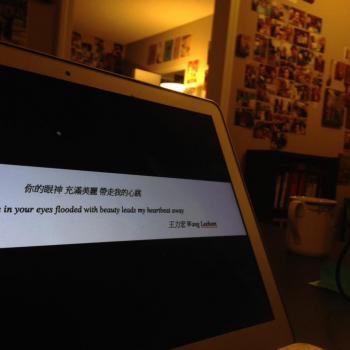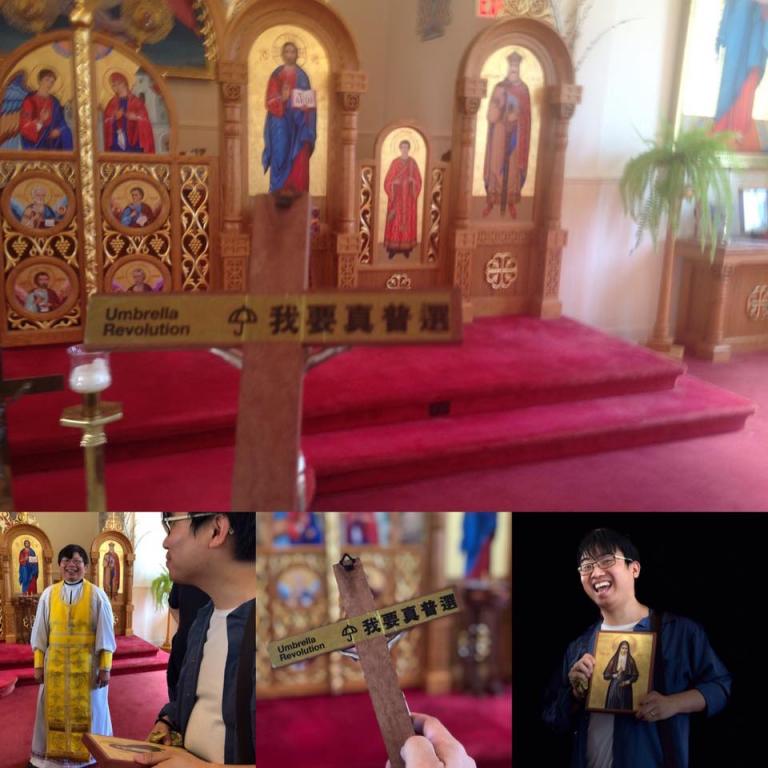
On Sunday, we celebrated the Feast of the Holy Grand Prince of Rus’ Volodymyr Equal-to-the-Apostles at the temple in Richmond. Coinciding with the celebrations, two material gifts were brought to the temple, one for us as a people and one for me personally. First, our ecumenical friends from St Francis’ Chapel on the Street in the Mong Kok occupation of the Hong Kong Umbrella Movement met our bishop and transported their crucifix via him to us. Second, I received as a personal gift for my own beautiful corner the icon of the Holy New-Martyr Elizabeth, who was a monastic from the royal family of Moscow after her husband was assassinated and who herself was killed by the Bolsheviks, from my dear friends Marie and Eugenia Geisel from the Latin Church in Seattle. As I contemplated these objects, my feeling was that these gifts accentuate the diaconal and ecumenical emphases of our Kyivan Church. I want to offer some reflections, then, on the experience of receiving these two materials in a temple where our people, few ethnic Ukrainians and many Canadians persuaded of our national ‘multicultural’ ideology as we have, tend to think of Holy Volodymyr and his grandmother Olha Equals-to-the-Apostles as ecclesial founders, not nationalistic figures.
It would be incorrect to suggest that folks in our Richmond temple don’t know anything about the Kyivan tradition. One of the first stories that our newcomers hear is the story of the conversion of Prince Volodymyr to Byzantine Christianity. As we tell the story of Volodymyr sending his emissaries to find a new religion and their report that they ‘did not know whether they were in heaven or earth’ when they experienced the liturgy in the Church of Holy Wisdom in Constantinople, we point to the icons of the Holy Equals-to-the-Apostles Volodymyr and Olha painted by the son-in-law of the Holy Hieromartyr Omelyan Kovch on both sides of our iconostas. The lesson of the story is not that we should be loyal to the nation that gave our church birth. Instead, it is that the lived experience of worship is probably more important for understanding evangelization than theological theory. Neither Volodymyr nor his emissaries were sophisticated theologians. Instead, they experienced the ways in which their political neighbours worshipped and chose the religion that moved them beyond words.
When our people are gaslit by some Orthodox folks (mostly the converts among them) for being ‘Ukrainian nationalists,’ we therefore tend to be puzzled. Our Kyivan consciousness is mostly liturgical. What we tend to struggle most with is learning the Galician tones, singing the liturgy in tune, and getting a regular kleros to show up on time, as we understand the Kyivan tradition to be mostly about enacting a beauty in the liturgy that will draw people at a level beyond and beneath ideology into the splendor of G-d himself. The political dimensions of our church’s work follow from this kind of conviction about liturgical evangelization. A number of us former Chinese evangelicals encountered the Kyivan Church through their local solidarity with the Umbrella Movement in Hong Kong. We learned about the events on the Maidan in Kyiv nine months before not as a nationalist statement, but as the Revolution of Dignity, as a call to social justice in Ukraine that mirrored similar activities in Hong Kong and Vancouver. In response to social injustice, we tend to offer prayer services, which brings us back to our struggle for musical coherence in the attempt to do something that falls increasingly less short of not knowing whether we were in heaven or earth. For those of us who encounter the gaslighting of our Orthodox sisters and brothers, we do not really understand why we – and our church, by extension – are called neo-Nazis and neo-fascists, even as our accusers bring up everyone from Josaphat Kuntsevych to Stepan Bandera to make us think that our acts of social justice and anti-racist protest are motivated by what must be a kind of secret fascism. It has taken me quite a long period of conversation and discernment to discover that perhaps their catechumenates and mystagogical training includes a fair bit of nationalist formation, whereas ours does not.
I was therefore overjoyed to receive the icon of the Holy New-Martyr Elizabeth as a gift from my Seattle friends. The way it happened was sudden, unexpected, and serendipitous. I had posted a photo of an icon on my Facebook timeline, whereupon my friends reached out to me with a photo of the New-Martyr asking whether I owned ‘this one.’ Unwilling to demonstrate my ignorance as to who this nun was – whom I was so certain was a Latin (truth is, I suspected it was St Faustina Kowalska) – I said, Not yet. No sooner were these words spoken that I was told that it was in the mail en route to me. The next day, I received word about who the mailman would be: it was one of our temple’s Parishioners-at-Large, himself a Latin Catholic but who is near and dear to our hearts, who lives in Seattle looking for an excuse to worship with us in Richmond.
It was not until after this exchange that I learned that the icon was that of a New-Martyr of the royal family of Moscow who had been killed by the Bolsheviks. Elizabeth was murdered the day after the more famous execution of the Romanovs by an incompetent firing squad that had to bayonet the family members they failed to shoot properly. Herself a survivor of the assassination of her husband, Elizabeth in her old age was pushed down a mine shaft, and when that didn’t kill her (she sang psalms the whole way down), they sent down some live grenades to finish the job. I knew the story of the Romanovs, but did not learn about Elizabeth till I was being sent the icon. I realized that our Kyivan Church is not supposed to be fans of such Russian imperialists, but truth be told, my reflection was much more perverse. It occurred to me that Nicholas II was not exactly the most competent of the Grand Princes of Moscow, which is what arguably exacerbated the Soviet uprising, so there seemed to me some poetic irony in their executions being executed so incompetently. I suppose these are not particularly welcomed thoughts for my friends with attachments to the Church of Moscow, as today happens to be the commemoration day for the Romanov New-Martyrs, though I sometimes wonder whether some attentiveness to contradiction in their own ecclesial lives might enable some of them to become a bit more humorous. In particular, my Orthodox critics tend to be what C.S. Lewis used to call Very Serious People.
In fact, I am happy to reveal more of my perversions. If I were to be even more honest, I have been thinking about the Romanovs more and more due to a project on psychoanalysis and publics I’ve recently started. I’ve redecorated my bathroom in Chicago with pictures of psychoanalysts, leftist revolutionaries, and political conservatives and imperialists, all as a kind of psychoanalytic joke about totalitarian ideology. Above one of the mirrors, I’ve hung pictures of the Romanovs along with a photo of Rasputin and a movie poster for Anastasia, the cartoon that I hate to admit is my original source for learning about the royal family once upon a December. There, I’ve put up an icon of the New-Martyrs at first as a joke. But it didn’t feel right to not venerate it, since it is an icon. Accordingly, when I go around the house kissing icons during my prayers, I admit to kissing them too. I’ll also put Elizabeth into my icon corner now too when I get back.
I’m not sure what the foregoing discussion about my perverse veneration of the Romanovs says about me, except that I am most certainly ideologically promiscuous. Indeed, I gladly receive Holy Elizabeth’s icon precisely because there is no nationalistic motivation driving either its gifting nor its reception. It was given to me by friends in the Latin Church who know that I like icons. I receive it as someone for whom the gifting of icons is always a kind of word from God to challenge me to expand my reflections on the oikonomia. This moment is one of those times. What does it mean, for example, when the Russian churches from the Moscow Patriarchate to the Russian Orthodox Church Outside Russia (ROCOR) canonize those we experience as imperialists? What does it mean, in turn, that we have staunch monarchists in our own church pining for the Hapsburgs to the point where they transfer their monarchical nostalgia to the British royal family? What does it mean that I used to be a devotee of the Radical Orthodoxy that has devolved into making arguments that a restoration of imperialist monarchy is the only future of radical democracy while denying that they are just Burkean conservatives? And the kicker: what does it mean that the gifting of this icon had nothing to do with any of these political questions because it’s a gift from my Latin friends – which they incidentally received from an Antiochian relative, further relativizing the nationalism – and I thought that the monastic displayed was a Latin nun?
I hesitate to offer any answers to any of these questions, as I have not yet had time to begin working on them. But I suppose one avenue for addressing them comes from my surprise at having ended up in what the Anabaptists would call a ‘Constantinian church.’ We call Volodymyr and Olha ‘Equals-to-the-Apostles,’ a title invented for Constantine and his mother Helena, and what we mean by it is that the Christianization of the imperium is the most effective kind of evangelization possible, as whole peoples become baptized into the faith. It is one of the sources of what has been called a symphonia between empire and church, that in an ideal sense, the temporal rulers of the imperial power act in concert with the church in her teaching and liturgy. The potential for social justice in this sense is great indeed. Volodymyr is a case in point, starting poor houses and hospitals in Kyiv after his conversion. So too, Elizabeth the New-Martyr started a home in Moscow for the poor. My colleague Henry Karlson goes as far as to put Elizabeth on the same par as Edith Stein and Teresa of Calcutta, for their execution of a feminist ethic of care among the poor. So too, Russian Catholic friends of mine noted that venerating Holy Elizabeth would further develop my Russian Catholic sensibilities, which is a legitimate development of a Kyivan sensibility as our church (especially Metropolitan Andriy Sheptytsky) was pivotal in getting the Russian Greek Catholic Church started and maintains an advocacy line for them to have an exarch to this day. Someone told me that there is a monastery in Minsk whose patron saint is Elizabeth where some of the best vestments in the world are made. I reflected that perhaps the Lord was moving me from perverse veneration to authentic prayerful reflection on what the Church of Moscow has offered the world. Certainly, Metropolitan Andriy would be happy with this development. Indeed, Bishop Borys Gudziak has called for reconciliation among Ukrainians and Russians even in the midst of the hybrid war of aggression from Russian troops in Crimea and Donbas that has led to so many tragedies, including mass refugee displacement and the felling of the commercial aircraft MH-17, whose anniversary we commemorate today.
But I think the difference that being in the Kyivan Church affords is our emphasis on our groundedness, not our ideology. Ideological promiscuity is possible because we are not so much concerned with abstract ideas with which we must conform but with the actual experience of liturgy, beauty, and social justice from the ground up. We are, as my friend Julian Hayda argues constantly, an ‘anti-colonial people,’ which means that we are not really in the business of fitting into fantasy grids about what we are about and much more about our ongoing conscientization about how we have been colonized. We are not experts, as we only have our own experience to work with, so this process tends to be imperfect, flawed, given to blind spots and infighting, ideologically confounding, and lacking in coherence as we struggle to recognize the sources of our own idiocy. It is here, I’d argue, that the larger shared experience of our church around Maidan and the particular encounter of Hong Kong people with the Kyivan Church in the Umbrella Movement reveals the limits of articulating symphonia as necessarily between imperium and sacerdotium.
The way that the cross from St Francis’ Chapel on the Street arrived at our Richmond temple might serve as a good example of our developing insight about symphonia. Our Kyivan bishop spoke at several events in Hong Kong in June, where he shared about the experience of the Kyivan Church being forced underground, how we came back from the dead after the fall of the Soviet Union, and why our bishops were together with their people on the streets when they protested on the Maidan. Arrangements were made for him to meet with some Hong Kong people who had protested on the streets during the Umbrella Movement, including some who were part of the ecumenical street shrine called St Francis’ Chapel on the Street, where they had displayed icons, organized contemplative prayer services, engaged in theological teaching about social justice and civil disobedience, and handed out the blessed bread that we Orthodox call antidoron to all passing by. It turns out that some of those very people had been trained by my spiritual father now here in Richmond in Byzantine liturgy, and they had contacted him during the Umbrella Movement for his solidarity. Through our bishop, they sent us a cross from that street sanctuary, which was the second gift that arrived for the Feast of Holy Volodymyr.
The insight that developed out of Maidan has been articulated well by our Patriarch. Quoting Pope Francis, Patriarch Sviatoslav explained that shepherds should take on the smell of their sheep. If the people were on the streets protesting for their own dignity, should not their hierarchs be among them? In this formulation, imperial symphonia does not seem absolute, and it certainly bears out Aristotle Papanikolaou’s insight that the whole point of symphonia is that the church is not identified with the empire because it is them being distinct from each other that was the precondition of them being two separate spheres in concert with each other. But the larger point – and I think here I am still following Papanikolaou’s path toward an Orthodox theory of radical democracy – not every regime is baptized by the church because what this baptism should lead to is a greater sense of social justice. Here, then, the symphonia is between the church and the people, the demos – or what Anthony Kaldellis calls the politeia, the res publica where the people who constituted the political order in the glory days of Constantinople-New Rome are their own true rulers and give the emperor a kind of representative legitimacy. Authoritarianism is not a Byzantine concept; it is its perversion.
Like Maidan, the Umbrella Movement is part of the emergence of a kind of precarious and flawed anti-colonial, anti-authoritarian politics in unexpected places. But as those who know the situation in Hong Kong well will readily admit, the movement is as fragmented and ideologically incoherent as its Ukrainian counterpart. Upon reflection, this problem is actually why the church is not taking a side, so to speak, by being on the streets among its people in such occupy protests. The church is not prescribing a path beyond the authoritarian order being protested. It is instead providing an atmosphere of liturgical prayer for the difficult task of discernment, debate, and dealign with disillusionment. For us to receive the crucifix from St Francis’ Chapel on the Street – a street sanctuary that itself dissolved before the end of the Umbrella Movement because of infighting – is an honor because it recognizes that our work in Richmond was a real act of ecclesial solidarity that was felt in Hong Kong.
I am not really sure what these reflections say about the Kyivan Church, except that I have thrived in my ideological promiscuity in liturgies where I don’t know whether I’m in heaven or earth. Perhaps a final story will suffice as a conclusion. At coffee hour after our liturgy for the Feast of Holy Volodymyr, I was sitting across the table from someone who was saying that she wanted to work on social justice with a certain institution that I thought was a bit conservative in its views. I voiced my views, to which my interlocutor quipped, Have you met me? I am conservative! Someone from the next table then piped in: We are all more conservative than you, Justin! I then looked at a newcomer who was listening to this discussion nervously, and with a look of great perversion, I explained nonchalantly, I am a far left radical. The room burst into laughter, someone made fun of the Green Party, and I got up to get seconds on our church lunch of instant noodles and dumplings. Every time I look at that Umbrella Movement crucifix and the icon of the New-Martyr Elizabeth, they will probably remind me of this moment and how scandalously diverse an anti-authoritarian politics looks.

